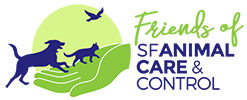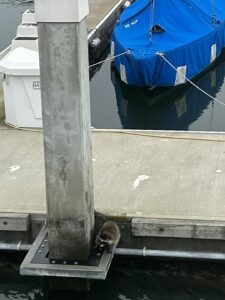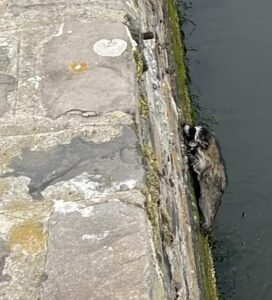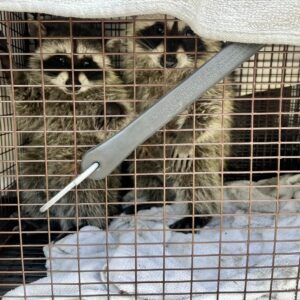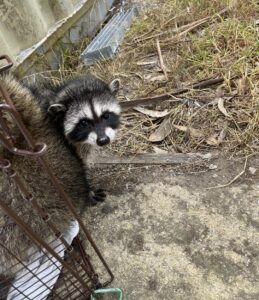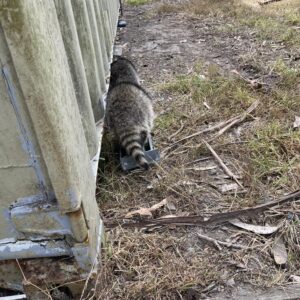Late one sunny morning two residents were walking along the path in the Marina when they noticed two young raccoons circling a post at a pier. They seemed to be struggling to find their way back to solid ground. It was way past their bedtime and with more and more people running and biking on the well-used paths along the waterfront, the raccoons were trapped on the pier and needed some assistance to get past the crowds. I was called out to help these young kits get back to a more suitable environment.
On my way there, the reporting resident that was standing by sent me an update that the raccoons had decided to swim across and attempt to climb a wall up to the shore. After a few failed attempts they were unsuccessful and swam back to the pier for a rest.
When I arrived on scene, I located the tired raccoons and quickly got to work helping them out of this stressful situation. One drenched raccoon was on the edge of the pier curled up in a ball leaning against a pole. Not wanting to scare him and knowing I really had only one chance before he jumped back in the water, I used a net and held it behind me as I approached very slowly. I slowly brought the net around and over the young raccoon. Once in the net he was snarling and letting me know how tough he was. Thankfully he was young and easier to get out of the netting and into the wire transport carrier. His sibling had wedged himself under the ramps to the pier and I was able to get him out using our more preferred method when dealing with raccoons: the humane catch pole. We use a pole that has a loop at the end that we secure around the animal to safely move them. We have to wait until we have the loop secured around the animal’s head and then we have to get them to step one leg forward so that the arm fully goes through the loop. This can take a lot of time and patience. Once the arm is fully through the loop, we quickly tighten the loop around the animal’s torso and safely move the animal. The siblings were reunited in the transport carrier, a little bickering ensued, but they soon calmed down once they were covered with a towel and transported past the ever-growing crowd of spectators. I found a spot just a few yards away that was a safe and secure place to release them. They were reluctant to get out of the carrier, but once they did, they were off on their way. They tucked under the trailer, eager to find a place to sleep, away from all of the commotion.
I wanted to be sure that I released them in a nearby location as these kits are probably still traveling with and learning from their mother and other siblings. They travel as a family unit for the first year of life then, split off to find territories of their own, living mainly solitary nocturnal lives. While most animals use sight and hearing to find and differentiate food, raccoons use their sense of touch. Which is helpful since they mainly hunt for food in the darkness of the night. Raccoons can heighten their sense of touch through a behavior called dousing. Raccoons are often seen placing objects or food in water as if they are washing them, but what they are doing is wetting their paws to stimulate the nerve endings. Like light to the human eye, water on a raccoon’s hands gives it more sensory information to work with, allowing the raccoon to feel much more than it would otherwise.
Raccoons are important to our urban ecosystem so if you ever see a raccoon that is out of place, injured or appears to be sick, please give our dispatchers a call at 415-554-9400. We will ask a few simple questions and send an officer out to respond to the situation. Thank you to the public who always help to keep us informed on the welfare of all of the animals that inhabit our city.
